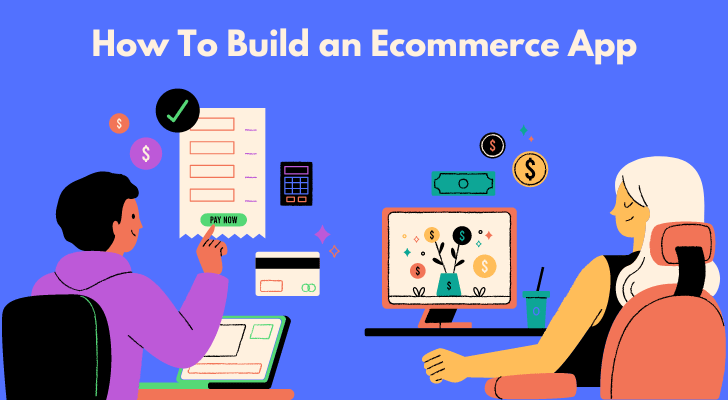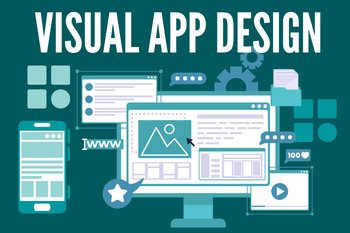Do you want to learn how to build an eCommerce app? The eCommerce industry is rapidly growing, and building an app is a great way to get your business up and running quickly.
In this article, we’ll discuss the steps you need to take to create an effective eCommerce app, from planning and development all the way through to launch.
We’ll also provide tips for marketing your new app and ensuring its success. With the right strategy and a bit of hard work, you can have an eCommerce app up and running in no time!

How To Build an Ecommerce App - article contributed by Ravi Makhija
12 Steps To Build An Ecommerce App
Do you want to build an ecommerce app but don't know where to start? Don't worry, this guide breaks down the steps of building an online store into easy-to-follow instructions. From choosing the right platform to setting up payment processing and marketing your app, these 12 steps will help you create a successful ecommerce app.
Step 1: Come up with an innovative idea for the ecommerce app
Having an innovative app idea is the first step in the app building process. An innovative idea for an e-commerce app would be to create an app that allows customers to post items they want to buy, and have sellers bid on them.
This would work in a similar way to auctions, but with the added convenience of being able to do everything through the app.
Sellers would be able to list their products, and buyers would be able to search for specific items or browse through the available products.
The app could also include features such as shipping tracking, ratings and reviews, and payment processing.
Furthermore, it could integrate with social media platforms so that buyers can share their experiences with friends or family members.
This type of e-commerce app could revolutionize online shopping by creating a more efficient and interactive marketplace for buyers and sellers alike.
Step 2: Identify Your Targeted Audience
Identifying your targeted audience is essential when creating an ecommerce app. Knowing who will be using the app can help you make informed decisions on what features to include, how to design the user interface, and what marketing materials to use.
When considering your target audience, think about factors like age, gender, location, occupation, interests, and lifestyle. It's also important to consider how users interact with technology.
If a majority of your target audience is older adults who may not be familiar with smartphones or apps, then you'll need to develop an intuitive user experience that's easy to navigate and understand.
Additionally, understanding which platforms your target audience uses (Android versus iOS) can help inform which platform you should develop for first.
With an understanding of your target audience's needs and behaviors, you can create an ecommerce app that meets their needs and provides value.
Step 3: Perform Market Analysis

To determine the demand for an ecommerce app, market analysis is essential. This involves researching the target customer base, the competition, and industry trends.
Additionally, the design and development team should review consumer preferences and behaviors to understand what features customers are looking for in an app.
To ensure the success of the app, it is also important to analyze customer feedback from existing competitors’ apps.
This can help identify areas for improvement when designing a new product. Furthermore, analyzing customer reviews not only gives insight into how to create a better UX but also helps in understanding what types of products are more desirable in the current market.
Finally, surveying potential customers can provide valuable data on their needs and wants when it comes to an ecommerce app.
All these elements should be considered while performing market analysis for the ecommerce app to determine its demand and potential success rate in the current market.
Step 4: List Down The Essential App Features
When planning an ecommerce app, there are certain essential features that need to be included. These features can help create a successful and user-friendly platform for customers.
An efficient search engine is one of the most crucial components, as it allows customers to quickly find what they are looking for. A secure payment system is also important, as it helps ensure that customers’ financial information is protected. Additionally, a reliable customer service feature should be included in order to provide assistance when needed.
An intuitive user interface should also be included to make it easy for customers to navigate the app and find items quickly. Finally, a comprehensive product catalog should be featured so that customers have access to a wide variety of products and services.
All of these features will help create an effective ecommerce app that meets customer needs and creates a positive overall experience.
Step 5: Create App Prototype For App
Creating a prototype for your app is a great way to get started with the development process. It helps visualize the features and interface of the app, and can be used as a roadmap for what needs to be done next.
When creating a prototype, it is important to think through the user experience and ensure that all the necessary functions are included.
Think about how users will interact with the app and navigate it. Sketch out how different screens will look and how information will be organized. Consider what kind of feedback you want from users and incorporate it into your design.
Once you have a basic prototype in place, start testing it out with friends or family to get their feedback on how to improve it further. With an app prototype in hand, you can then move on to developing a more advanced version of your app.
Step 6: Create Visual App Design

Creating visual app designs can be a lot of fun, and it's also a great way to bring your ideas to life! Visual design is important for creating an engaging and intuitive user experience.
The goal is to create a design that will make users feel comfortable with the app, while also making it visually appealing.
When designing an app, consider how the visual elements will be used to communicate information, guide users through the app's functionality, and evoke user emotion.
Think about how different colors, shapes, typography, and imagery can be used to draw attention to key features or areas of the app. Additionally, use contrasting colors and patterns to create depth in your design and help guide users throughout their journey.
With thoughtful consideration put into every aspect of the design process, you can create an amazing visual experience for users!
Step 7: Choose Right Technology for App Development
When it comes to app development, choosing the right technology is critical. It can make or break the success of an application.
The developer needs to consider various factors while selecting a technology, such as the size and scope of the project, budget, user interface requirements, scalability, and security needs.
For example, if you want to develop a mobile application, you may choose HTML5 for its cross-platform support or Android/iOS for their specific platforms.
Similarly, if you are working on a web application, then PHP/Python/Ruby on Rails are some of the popular choices. Choosing the right technology can help optimise development time, reduce costs, and ensure long-term application performance.
Supercharge Your AWeber Account
Take Your Email Marketing To The Next Level With These Powerful Tools
Step 8: Develop Your Ecommerce App
Developing an ecommerce app can be a great way to expand your business and reach a larger audience. You'll need to consider the platform you want your app to run on, such as Android or iOS.
After deciding on the platform, you should create a detailed plan for how your app will work and what features it will offer. It's important to focus on the user experience when developing an ecommerce app, so customers have an enjoyable shopping experience.
App development broadly comprises two parts - Front end and backend development.
Front-end Development:
Front-end development is very important to attract the attention of the target users. While writing the codes for the front end, make sure that the app's appearance is attractive, uncluttered and easy to navigate.
Before starting your front-end development process, you must carefully consider whether you want to develop a native or a hybrid app. These apps have challenges and therefore need different approaches to finding the optimum solution.
Hybrid apps offer multiple advantages:
- They are cost-effective.
- Integrate easily with other apps.
- Multi-platform support
Native apps also offer numerous advantages:
- Superior performance
- They provide an app store advantage
- They are more secure
Back-end Development:
The back-end can be termed as the brains behind any app, so you have to be very careful in its development process so that the app you are developing provides the users with a fantastic user experience.
When you are planning to code for the back end of your app, you have two options:
- Using a back-end platform to make the entire process faster
- Creating the entire back end o your app from ground-up
Both these processes have pros and cons, and you have to carefully check to find which one is best for your needs.
If you are looking to develop the frontend and backend of your app then you can hire a dedicated developers or you can get in touch with an ecommerce app development company. They will help you with your ecommerce app development, You can also get free consultation from them.
Step 9: Test Your Ecommerce App

Test Your Ecommerce App
Testing your ecommerce app is a crucial step in the development process and should not be overlooked. It allows you to identify any potential issues or bugs that could negatively impact the user experience or even lead to financial losses.
The best way to test an ecommerce app is to create real-world scenarios such as attempting to purchase products, setting up shipping options, creating customer accounts, and checking out using various payment methods.
By doing this, you can ensure that all features are working correctly and that the user experience is smooth from start to finish. Additionally, it’s important to monitor user feedback and make necessary changes or improvements based on it.
Testing your ecommerce app thoroughly before launch will make sure that the app will work flawlessly.
Step 10: Launch Your Ecommerce App
Launching an ecommerce app is a great way to tap into the digital marketplace and reach customers around the world.
The key to success is creating an intuitive, user-friendly experience that allows customers to quickly and easily find what they are looking for.
To start, you will need to identify your target market, create a website or app that reflects your brand, and design the user interface in a way that makes it easy for customers to navigate through categories and products.
Once you’ve built your platform, launch your app by promoting it through social media, SEO optimization, influencer marketing, email campaigns, and online advertisements. With the right strategies in place, you can successfully launch your ecommerce app.
Step 11: Promote Your Ecommerce App
Promoting your ecommerce app in the app stores is a great way to attract more customers. You can use various tools, such as app store optimization, search engine optimization, and paid advertising, to reach out to your target audience.
Besides these methods, you can also create engaging content that will help you reach a larger audience.
Step 12: Update And Maintain Your Ecommerce App
Updating and maintaining an ecommerce app is essential for the continued success of any online store. Regular updates to the app ensure that it is up to date with the latest security patches, which can protect customer data and provide a better overall user experience.
Additionally, regular maintenance allows developers to identify and fix any potential problems as soon as they arise, ensuring that customers have a smooth shopping experience. This could include fixing bugs, adding new features, or updating existing ones. It’s important for businesses to regularly review their ecommerce app and make sure that all components are working flawlessly.
Conclusion
In conclusion, building an ecommerce app is a complex process that requires careful planning, development, and testing. However, the time and effort invested will provide you with a powerful tool to reach a large audience of potential customers.
With the right strategy, you can build an ecommerce app that can help grow your business and increase your profits.

Author Bio: Ravi Makhija
Ravi Makhija is an entrepreneur, an IT professional, tech geek, founder & CEO at Guru TechnoLabs - Globally Trusted Web & Mobile App Development Company. He loves writing about new technologies and the latest trends in the IT field.
Did You Know You Already Have A LOT To Sell?
So What's Your Problem?

